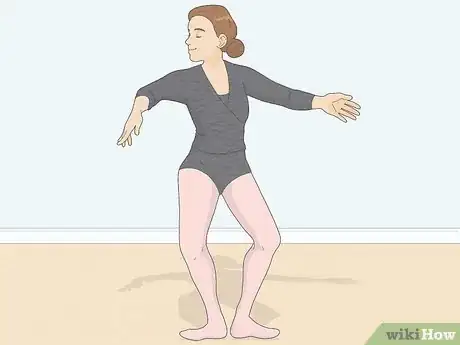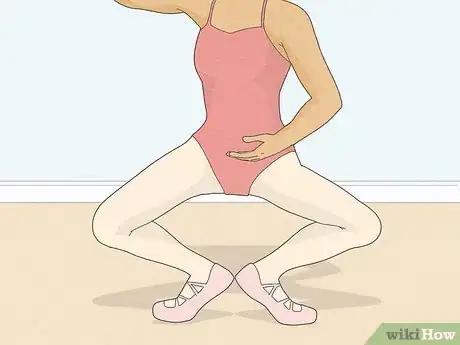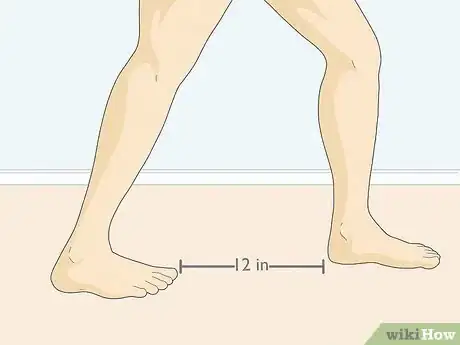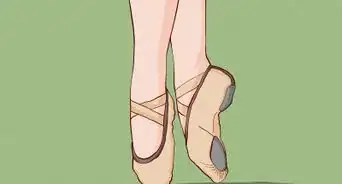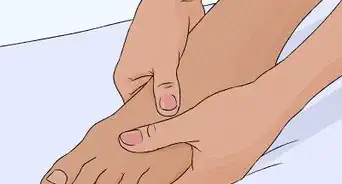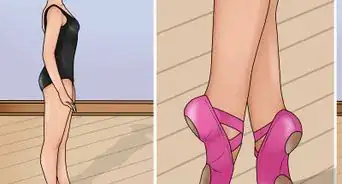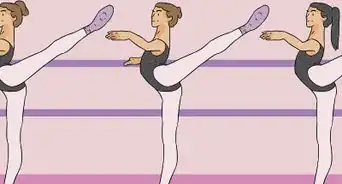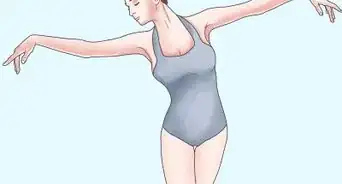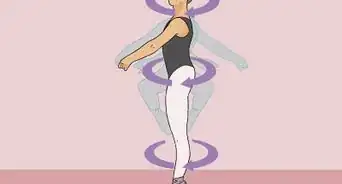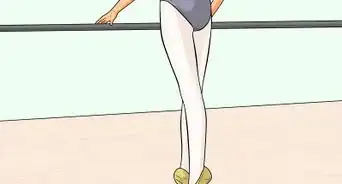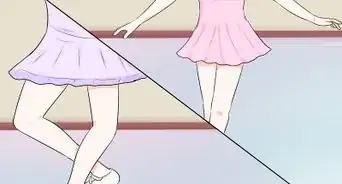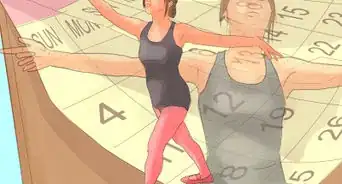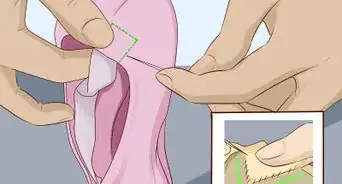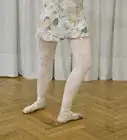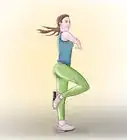This article was co-authored by Geraldine Grace Johns and by wikiHow staff writer, Hannah Madden. Geraldine Grace Johns is a Professional Ballerina and the Owner of Grace Ballet in New York and Los Angeles. Geraldine toured through New Zealand, Australia, Japan, and Korea as Jammes in Ken Hill's Original Phantom of the Opera. She has studied with the Royal Academy of Dance in London to become a teacher and taught for the Kudo School of Ballet in Yokohama. Geraldine also ran her own Royal Academy of Dance School in New Zealand before studying at the Neighborhood Playhouse School of the Theatre in New York City. Geraldine was a guest coach and Master Class teacher in Toronto for the Canadian Royal Academy of Dance's Dance Challenge in 2018, 2019, and 2020. She was also a guest coach and Master Class teacher for the USA Royal Academy of Dance Challenge in Long Beach, California in 2019 and 2020. Grace Ballet Los Angeles has won recognition as one of 13 Best Ballet Schools in Los Angeles since opening her school. Geraldine is a contract Practical Teaching Supervisor for the Certificate in Ballet Teaching Studies for the Royal Academy of Dance.
There are 9 references cited in this article, which can be found at the bottom of the page.
This article has been viewed 182,504 times.
A plié is a simple ballet step that is learned while covering the basics. Although it’s often taught to beginners, it’s one of the most important movements that you’ll learn because it’s used in so many different dance steps. By nailing the right form and correct body positions, you can learn how to plié in minutes—however, mastering the form can take years, so keep practicing! Read on to learn how to do a plié.
Steps
What are the 2 different types of a plié?
-
1A demi-plié is a bend in the knees with your heels on the ground. You won’t bend down as far in a demi-plié, and you might need to work a little more on your balance and control. This is usually the first type of plié that you’ll learn.[2]
-
2A grand-plié is a bend in the knees with your heels off the ground. In this plié, you’ll bend down as far as you can go while keeping your spine straight and your backside tucked. It can take a little more strength and muscle to control the plié all the way back up.[3]
How do you do a demi-plié?
-
1Start in first position and bend with your knees. Turn out in first position using your hip joint.[4] Start by bending your knees just slightly, keeping your upper body straight with your shoulders down. Don’t stick your backside out or adjust your hips—simply lower at the knees while keeping the rest of your body straight.[5]
-
2Keep your heels planted. Stop bending your knees when they extend just over your toes. If you feel your heels starting to come off the ground, stop bending.[6]
-
3Rise slowly and gracefully back into first position. Push your weight straight down into the floor with your legs and feet to push yourself back up. Continue keeping your shoulders down, head up, and bottom tucked during the upward movement. Continue rising until your thighs and knees are back together in your starting position.[7]
How do you do a grand-plié?
-
1Bend with your knees as you lift your heels off the ground. Since you are bending further down at the knees in a grand-plié, your heels will naturally come off the ground. Even though the weight shifts to the forward parts of your feet entirely, your upper body should be perfectly straight, meaning your center of gravity should still feel as though you are standing with legs straight.[8]
-
2Continue bending your knees until your thighs are parallel with the floor. Once your heels come off the ground, keep bending your knees even lower. Continue lowering as far as you can until your thighs are nearly horizontal and your knees are almost fully bent.[9]
-
3Rise back to first position. Engage your quads and glutes to push your body back upwards into your starting position. When rising, use your feet and legs rather than simply the knees to straighten. Push down with your raised heels to reconnect them with the floor as soon as possible in the rising motion.[10]
Which muscles do you use in a plié?
-
1Your abs keep your spine and upper body straight. It’s important not to hunch over or bend your spine as you lower down. You can control your movements by engaging your core and your abs to lock your spine into place.[11]
-
2Your legs and glutes control your downward and upward motion. As you bend down, engage, your glutes, quads, and hamstrings to slow your movement. When you rise up, engage your glutes, quads, and hamstrings again to push yourself up slowly without jerking your body around.[12]
Which stretches help with a plié?
-
1Do calf stretches for a deeper plié. Place your hands on a wall or the barre and stick one foot out about 12 in (30 cm) behind you. Bend your front knee and push your back heel down onto the floor until you feel a stretch in your calf, then hold it for about 30 seconds. Repeat this on the other leg.[13]
-
2Stretch your inner thighs with a butterfly stretch. Sit down on the ground and pull your heels in toward yourself, letting your knees splay outward to create a diamond shape with your legs. Rest your elbows on your knees and slowly lean forward until you feel a stretch in your inner thighs. Hold the position for 30 seconds to 1 minute at a time.
Expert Q&A
Did you know you can get premium answers for this article?
Unlock premium answers by supporting wikiHow
-
QuestionHow can I improve my plie?
 Geraldine Grace JohnsGeraldine Grace Johns is a Professional Ballerina and the Owner of Grace Ballet in New York and Los Angeles. Geraldine toured through New Zealand, Australia, Japan, and Korea as Jammes in Ken Hill's Original Phantom of the Opera. She has studied with the Royal Academy of Dance in London to become a teacher and taught for the Kudo School of Ballet in Yokohama. Geraldine also ran her own Royal Academy of Dance School in New Zealand before studying at the Neighborhood Playhouse School of the Theatre in New York City. Geraldine was a guest coach and Master Class teacher in Toronto for the Canadian Royal Academy of Dance's Dance Challenge in 2018, 2019, and 2020. She was also a guest coach and Master Class teacher for the USA Royal Academy of Dance Challenge in Long Beach, California in 2019 and 2020. Grace Ballet Los Angeles has won recognition as one of 13 Best Ballet Schools in Los Angeles since opening her school. Geraldine is a contract Practical Teaching Supervisor for the Certificate in Ballet Teaching Studies for the Royal Academy of Dance.
Geraldine Grace JohnsGeraldine Grace Johns is a Professional Ballerina and the Owner of Grace Ballet in New York and Los Angeles. Geraldine toured through New Zealand, Australia, Japan, and Korea as Jammes in Ken Hill's Original Phantom of the Opera. She has studied with the Royal Academy of Dance in London to become a teacher and taught for the Kudo School of Ballet in Yokohama. Geraldine also ran her own Royal Academy of Dance School in New Zealand before studying at the Neighborhood Playhouse School of the Theatre in New York City. Geraldine was a guest coach and Master Class teacher in Toronto for the Canadian Royal Academy of Dance's Dance Challenge in 2018, 2019, and 2020. She was also a guest coach and Master Class teacher for the USA Royal Academy of Dance Challenge in Long Beach, California in 2019 and 2020. Grace Ballet Los Angeles has won recognition as one of 13 Best Ballet Schools in Los Angeles since opening her school. Geraldine is a contract Practical Teaching Supervisor for the Certificate in Ballet Teaching Studies for the Royal Academy of Dance.
Professional Ballerina & Ballet Instructor
-
QuestionWhat if I don't have a teacher and I'm learning the plié. How can I know that I'm doing right or wrong?
 wikiHow Staff EditorThis answer was written by one of our trained team of researchers who validated it for accuracy and comprehensiveness.
wikiHow Staff EditorThis answer was written by one of our trained team of researchers who validated it for accuracy and comprehensiveness.
Staff Answer wikiHow Staff EditorStaff Answer
wikiHow Staff EditorStaff Answer -
QuestionI find turning my hips out 180 degrees really easy, am I doing it right?
 wikiHow Staff EditorThis answer was written by one of our trained team of researchers who validated it for accuracy and comprehensiveness.
wikiHow Staff EditorThis answer was written by one of our trained team of researchers who validated it for accuracy and comprehensiveness.
Staff Answer wikiHow Staff EditorStaff Answer
wikiHow Staff EditorStaff Answer
Warnings
- Turn-out from your legs at the hip joints. Don't force your knees and ankles to bend at uncomfortable angles because it will lead to injury.⧼thumbs_response⧽
References
- ↑ https://www.britannica.com/art/plie
- ↑ https://ballethub.com/ballet-lesson/how-to-demi-plie/
- ↑ https://northlandschoolofdance.com/g-is-for-grand-plie-dance-terminology-a-z/
- ↑ Geraldine Grace Johns. Professional Ballerina & Ballet Instructor. Expert Interview. 11 November 2020.
- ↑ Geraldine Grace Johns. Professional Ballerina & Ballet Instructor. Expert Interview. 11 November 2020.
- ↑ https://northlandschoolofdance.com/g-is-for-grand-plie-dance-terminology-a-z/
- ↑ https://www.youtube.com/watch?t=109&v=NcmkLYmkUzM&feature=youtu.be
- ↑ https://ballethub.com/ballet-lesson/plie-basics/
- ↑ https://ballethub.com/ballet-lesson/plie-basics/
About This Article
In ballet, there are 2 different types of plié, the demi-plié and the grand-plié. To do a demi-plié, start in 1st position with your heels touching and your legs straight and turned out as close to 180 degrees as you can manage. Then, bend your knees a little until they line up with your toes while keeping your feet flat on the floor. Rise slowly by pushing with your legs and feet, and return to 1st position. Doing a grand-plié is much the same as a demi-plié, except that you should bend your legs as far as you can until your thighs are nearly horizontal and your knees are almost fully bent. For more tips, including how to keep your balance while practicing pliés , read on!
